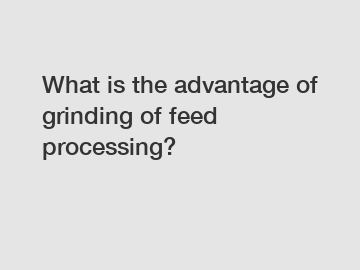What is the advantage of grinding of feed processing?
Grinding of Feed Processing: Advantages and Benefits.
Feed processing is an essential part of animal husbandry and agriculture. One crucial step in the feed processing chain is grinding. Grinding involves reducing the particle size of raw materials, such as grains or forages, to produce feed that is more easily digestible for animals. This article will explore the advantages and benefits of grinding in feed processing.
Improved Digestibility.

Grinding feed helps to improve the digestibility of nutrients for animals. By reducing the particle size of grains and forages, the surface area available for enzymes to break down the feed increases. This results in better absorption of nutrients and improved feed conversion rates. In turn, this leads to better growth rates, optimal weight gain, and overall improved performance of livestock.
Enhanced Nutrient Availability.
Another advantage of grinding in feed processing is the enhanced availability of nutrients. When feed is ground, the nutrients within the feed are more readily accessible to the animals' digestive systems. This ensures that animals receive the full nutritional benefits of the feed, leading to healthier animals and improved overall health.
Increased Feed Efficiency.
Grinding feed also helps to increase feed efficiency. With a finer particle size, animals can consume and digest the feed more efficiently. This means that less feed is wasted and more of the nutrients are utilized by the animals. Improved feed efficiency not only reduces feeding costs but also has a positive impact on the environment by reducing the amount of feed required to raise animals.
Consistent Feed Quality.
Grinding feed allows for greater control over the feed quality. By grinding feed ingredients to a specific particle size, feed manufacturers can ensure a consistent and uniform feed ration. This consistency is crucial for maintaining the health and performance of animals, as variations in feed quality can lead to digestive issues and nutrient deficiencies. Consistent feed quality also results in better feed conversion rates and improved production outcomes.
Reduced Sorting Behavior.
In some cases, animals may exhibit sorting behavior when fed a diet with large particle sizes. This behavior involves animals selectively consuming certain feed components while discarding others. Grinding feed to a finer particle size helps to prevent sorting behavior, ensuring that animals receive a balanced diet and all necessary nutrients. This leads to improved animal health and performance, as well as better overall feed efficiency.
Conclusion.
In conclusion, grinding of feed processing offers numerous advantages and benefits for animals, feed manufacturers, and the agricultural industry as a whole. From improved digestibility and enhanced nutrient availability to increased feed efficiency and consistent feed quality, grinding plays a crucial role in optimizing animal nutrition and performance. By investing in quality grinding equipment and practices, feed manufacturers can provide animals with a high-quality, easily digestible feed that promotes optimal growth and health.
Contact Us.
If you have any questions about feed processing or how grinding can benefit your operation, please do not hesitate to contact us. Our team of experts is here to help you optimize your feed processing practices and achieve the best possible outcomes for your animals.
Contact us to discuss your requirements of pelleting aid, Feed Cleaning Machine, feed pellet grading sieve. Our experienced sales team can help you identify the options that best suit your needs.

Comments